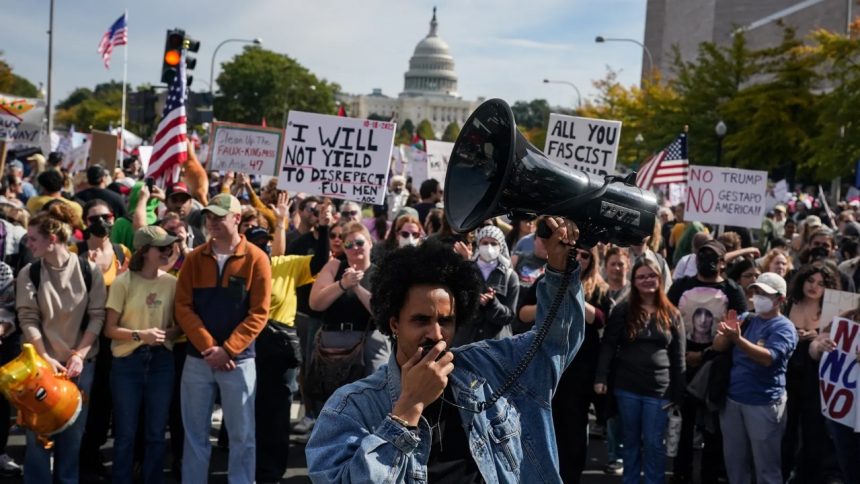On an unseasonably warm October day in 2025, the streets of American cities from Washington, D.C., to Los Angeles were awash with a sea of yellow. Millions of people, united by a single, powerful idea, gathered for the second wave of “No Kings” protests. This wasn’t a spontaneous outburst of anger but a coordinated national movement, a peaceful yet resounding declaration that in America, the power belongs to its people, not to a single ruler. The protests, organized by a vast network of progressive groups, were a direct response to what participants see as a dangerous slide toward authoritarianism under President Donald Trump’s second administration.
The “No Kings” movement draws its strength from a foundational American principle: opposition to monarchy. The very name is a deliberate echo of the nation’s revolutionary past, a reminder that the country was founded by rejecting the rule of a king. For modern protesters, this historical sentiment is a direct rebuttal to President Trump’s expansion of presidential power, which they view as monarchical behavior.
The movement first captured national attention in June 2025, when organizers said around 5 million people protested a military parade held for the Army’s 250th anniversary that coincided with Trump’s birthday. The October protests were even larger, with organizers reporting nearly 7 million participants at more than 2,700 events across all 50 states and in cities worldwide. The overwhelming message was that Trump, in their view, is governing more like a monarch than an elected official accountable to the people.
You Might Like: Inside Jelly Roll’s World: Fatherhood and His Wife Bunnie
More Than a Slogan: The Real-World Grievances
While the “No Kings” chant provides a unifying theme, the protests were fueled by a collection of specific and deeply felt policy concerns. Demonstrators voiced outrage over a wide range of actions taken by the Trump administration, creating a “big tent” of opposition. A central issue for many was the administration’s aggressive immigration tactics.
Protesters decried the immigration detentions carried out by often-masked Immigration and Customs Enforcement (ICE) agents and Trump’s push to deploy National Guard troops in Democratic-led cities like Chicago against the wishes of local and state officials. In Los Angeles, Mayor Karen Bass described the federal deployment of the Guard as a “move toward authoritarianism.” For participants like Maria Floriano in California, who wore butterfly-themed attire to symbolize migration, the protest was a way to tell immigrants that “not everyone feels that they’re not welcome here.”
Aerial view of the nationwide Anti-Trump ‘No Kings’ protest in Boston. pic.twitter.com/vY3PutY6qB
— Pop Base (@PopBase) October 18, 2025
Beyond immigration, protesters rallied against the administration’s aggressive slashing of federal programs, particularly in education and environmental protection. The ongoing federal government shutdown formed a tense backdrop for the rallies, with furloughed federal workers expressing fear and frustration over their livelihoods and what they described as the “demonization” of government employees. For others, concerns about gerrymandering and attacks on healthcare access brought them into the streets. These diverse issues were strung together by a broader anxiety about the erosion of constitutional rights and democratic norms, with many attendees fearing that the very foundation of American democracy is under threat.
A Peaceful, and Sometimes Playful, Resistance
In the face of what they perceive as authoritarian overreach, the “No Kings” movement made a conscious choice to embrace nonviolent and often whimsical protest. Organizers were “adamant that the rallies remain peaceful” and held virtual safety trainings ahead of the events. This commitment was largely fulfilled, with police in major cities like New York, Washington, D.C., and Austin reporting no protest-related arrests. The widespread use of the color yellow served as a bright symbol of unity and a nod to other nonviolent resistance movements around the world.
Perhaps the most striking feature of the protests was the festive atmosphere. In a clever rebuttal to rhetoric that painted them as violent radicals, many protesters showed up in inflatable costumes, dressing as unicorns, dinosaurs, and tacos. One protester in Los Angeles noted that it’s hard to characterize a gathering as a “war zone” when it looks like “a block party and people in Halloween costumes.” This display of joy and creativity was a strategic effort to de-escalate potential conflicts and project a different image.
As retired government worker Peggy Cole, who celebrated her 70th birthday at the DC protest, explained, she felt it was a “scary time” and that democracy was at risk, compelling her to take a stand. The “No Kings” protests were, ultimately, a detailed and passionate defense of a democratic ideal, carried out with a conviction that peaceful assembly is the most American tool of all.



